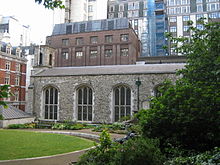Savoy Chapel
| Savoy Chapel | |
|---|---|
| Queen's Chapel of the Savoy | |
 |
|
| 51°30′38″N 0°07′12″W / 51.5105°N 0.1199°WCoordinates: 51°30′38″N 0°07′12″W / 51.5105°N 0.1199°W | |
| Country | United Kingdom |
| Denomination | Church of England |
| Previous denomination |
Lutheranism Roman Catholic |
| Website | royalchapelsavoy |
| Architecture | |
| Status | Royal Peculiar |
| Functional status | Active |
| Architect(s) | Richard Griffiths Architects (renovations) |
| Style | Tudor; Perpendicular |
| Completed | 1512 |
| Specifications | |
| Length | Nave: 200 ft (61 m) |
| Number of towers | 1 |
| Materials | Stone |
| Administration | |
| Diocese | London (location) |
| Province | Canterbury |
| Clergy | |
| Chaplain(s) | Rev Prof Peter John Galloway OBE |
|
Listed Building – Grade II*
|
|
| Official name: Savoy Chapel (Queen's Chapel of the Savoy) | |
| Designated | 24 February 1958 |
| Reference no. | 1264731 |
The Savoy Chapel, or the Queen's Chapel of the Savoy, is a church dedicated to St John the Baptist, located just south of the Strand, London, next to the Savoy Hotel.
It was founded in the Middle Ages as part of the main church of the Savoy Palace (later the Savoy Hospital). The ancient hospital had fallen into ruin by the 19th century and only the chapel survived the demolition enabling construction of an approach road at the north of Waterloo Bridge.
The chapel remains governed by the Duchy of Lancaster and as such is a royal peculiar, not being under the jurisdiction of a bishop, but under that of the reigning monarch. It is designated as a Grade II* listed building.
The chapel was founded as part of Peter of Savoy's palace which was destroyed during the Peasants' Revolt of 1381. The present chapel building commenced in the 1490s (being completed in 1512) by Henry VII as a side chapel off the Savoy Hospital's 200-foot (61 m) long nave (the nave was secular rather than sacred, held 100 beds and was demolished in the 19th century).
The Savoy Chapel has hosted various other congregations, most notably that of St Mary-le-Strand whilst it had no church building of its own (1549–1714). Also the German Lutheran congregation of Westminster (now at Sandwich Street and Thanet Street, near St Pancras) was granted royal permission to worship in the chapel when it separated from Holy Trinity (the City of London Lutheran congregation now at St Mary-at-Hill). The new congregation's first pastor, Irenaeus Crusius (previously an associate at Holy Trinity), dedicated the chapel on the 19th Sunday after Trinity 1694 as the Marienkirche or the German Church of St Mary-le-Savoy.
...
Wikipedia

